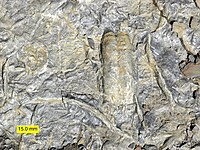ဇမြ
ဇမြ (အၚ်္ဂလိက်: fossil ဗၟာ: ကျောက်ဖြစ်ရုပ်ကြွင်း) ဂှ် ဒှ်အရာသၟေဟ် အရာမဂျိုင်လဝ်လမျီုဂမၠိုင် နူကဵုအခိင်အခါအတိက် ခေတ်ပထဝဳ။ ဥပမာ ဇုတ်၊ ဂၞာ၊ သၞောက်၊ တၞံဆု၊ စၟစၟောန်တအ် မချိုတ်အာလဝ် နူကဵု သၞာံမဂၠိုင်အသင်္ဃဲတုဲ ကတဵုဒှ် တၟအ်၊ တၟအ်ချး၊ ကၠေင်၊ ကေုာံ သၟေဟ်ဒဳအေန်အေဂမၠိုင်။
ဇမြ လဆောဝ် ချူ ဇရ။ ပ္ဍဲအဘိဓာန် နာဲထောန်ဝေဂှ် ညးချူလဝ် "ဇြတၟအ်"။ နကဵု ဘာသာဗၟာ ညးဗဒှ်လဝ် "ကျောက်ဖြစ်ရုပ်ကြွင်း"။ အဘိဓာန် မန်ဗၟာ နာဲသက်လောန်ဂှ် "ဇရ၊ ဇမြ (န) အမှိုက်။/ ၂။ အဆီ၊ အရည်စသည် ထုတ်ယူပြီး ကျန်သောအဖတ်။ ဇရလ္ၚဴ = နှမ်းဖတ်။ ရံင်ကဵု ပၟိက် အဘိဓာတ် နာဲသက်လောန် ဝွံတုဲ fossil ဝွံ နကဵုဘာသာမန် ကော်စ ဇမြ ဂှ် ဒးရးကိတ်ညဳဂၠိုင်အိုတ်ရ။ fossil ဂှ် အရာမဒှ်ဆတၟအ် သၟးဟွံသေင်၊ ကၠေင် မၜံက်ခါဲနူတိလေဝ် ဒှ်အရာသၟေဟ် နူကဵု အရာမဂျိုင်လဝ်လမျီု ပ္ဍဲအခိင်အတိက်တေအ်ကီုရ။ တုဲပၠန် ကၠေင်မၜံက်ခါဲ နူကဵုသၟဝ်ဂတာတိတေအ်ဂှ် ညးကော်စ နကဵုဘာသာအင်္ဂလိက် fossil fuel နကဵုဘာသာမန် ကော်စ "ကၠေင်ဇမြ" ဂွံကီုရ။
နိခါတကဗေဒ (Paleontology) (ဝါ) ပညာဇမြ ဂှ် ဒှ်ပညာ မလ္ၚတ် ဇမြဂမၠိုင် - အာယုက်ဍေဟ်တအ်၊ ဗီုလဵု ဍေဟ်တအ် မကတဵုဒှ်ကၠုင် ကေုာံ ဗီုလဵု ညးမပြံင်လှာဲကၠုင်။ အရာမွဲ ယဝ်ရ အာယုက် နွံလတူ ၁၀,၀၀၀ သၞာံမ္ဂး ညးစၟတ်သမ္တီ ဇမြ။[၁] ဇမြ အာယုက်ဇၞော်အိုတ်ဂှ် အာယုက် နွံ အကြာ ၂.၄၈ ဘဳလဳယာန်[၂][၃][၄] စဵုကဵု ၄.၁ ဘဳလဳယာန်သၞာံ။[၅][၆] The observation in the 19th century that certain fossils were associated with certain rock strata led to the recognition of a geological timescale and the relative ages of different fossils. The development of radiometric dating techniques in the early 20th century allowed scientists to quantitatively measure the absolute ages of rocks and the fossils they host.
အရာမွဲမွဲ ဍေဟ်ဂွံဒှ် ဇမြဂှ် လၟေင်ဒဒှ် နွံနာနာသာ်၊ မပ္တံ ကဵု (permineralization)၊ ဟိုတ် casts ကေုာံ ဗီုပြင် molds၊ authigenic mineralization, replacement and recrystallization, adpression, carbonization, and bioimmuration.
ဇမြတအ်ဂှ် နွံကဵု ဇၞော်နာနာသာ် နူကဵု ဍောတ်သောဲ မွဲ-မိကရဝ်မဳတာ (1 µm) မဒှ်စၟဗက်တေရဳယျာ[၇] စဵုကဵု ရုပ် ဒဳနဝ်သောdinosaurs ကေုာံ တၞံဆု ဇၞော်ဇၞော် မနွံကဵု ဇမၠိင် မဂၠိုင်ကဵုမဳတာ လျိုင် မဂၠိုင်ကဵု တာန်ရ။ ဇမြတအ်ဂှ် ဗွဲဓမ္မတာမ္ဂး ကပေါတ်ဇဳဝ မကတဵုဒှ်လဝ် မနွံကဵု ဓါတ်မိနေရာ နူကဵုအခိင်မနွံလမျီု မပ္တံကဵု ဇုတ်၊ င္ၚေက် ကေုာံ တၞံဆု၊ ဟွံသေင်မ္ဂး မနွံကဵု ဓါတ်ချိတိနု (chitinous) ဟွံသေင်မ္ဂး calcareous exoskeletons of invertebrates တအ်ရ။ ဒၞာဲဇိုင် သတ်လမျီုတအ် ဟွံသေင်မ္ဂး အသုဘသတ်လမျီုတအ်လေဝ် ဒှ်ဇမြ နွံကီုရ။ ဇမြ ဂကူဏအ်ဂှ် ညးကော်စ ပၞေတ်ဇမြ ဟွံသေင်မ္ဂး ichnofossils မဒှ်အရာ မ္ၚးခန္ဓ ဇမြတအ်ရ။ ဇမြလ္ၚဵုတအ်ဂှ် ဒှ်အရာ ဇဳဝဓာတုတုဲ ဇမြ ဂကူဏအ်ဂှ် ညးကော်စ ဓါတုဇမြ (chemofossils) ဟွံသေင်မ္ဂး biosignatures။
လၟေင်ဒဒှ် ဇမြဂမၠိုင် (Fossilization processes)
[ပလေဝ်ဒါန် | ပလေဝ်ဒါန် တမ်ကၞက်]The process of fossilization varies according to tissue type and external conditions.
Permineralization
[ပလေဝ်ဒါန် | ပလေဝ်ဒါန် တမ်ကၞက်]
Permineralization is a process of fossilization that occurs when an organism is buried. The empty spaces within an organism (spaces filled with liquid or gas during life) become filled with mineral-rich groundwater. Minerals precipitate from the groundwater, occupying the empty spaces. This process can occur in very small spaces, such as within the cell wall of a plant cell. Small scale permineralization can produce very detailed fossils.[၈] For permineralization to occur, the organism must become covered by sediment soon after death, otherwise the remains destroyed by scavengers or decomposition.[၉] The degree to which the remains are decayed when covered determines the later details of the fossil. Some fossils consist only of skeletal remains or teeth; other fossils contain traces of skin, feathers or even soft tissues.[၉] This is a form of diagenesis.
Casts and molds
[ပလေဝ်ဒါန် | ပလေဝ်ဒါန် တမ်ကၞက်]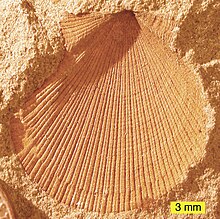
In some cases, the original remains of the organism completely dissolve or are otherwise destroyed. The remaining organism-shaped hole in the rock is called an external mold. If this hole is later filled with other minerals, it is a cast. An endocast, or internal mold, is formed when sediments or minerals fill the internal cavity of an organism, such as the inside of a bivalve or snail or the hollow of a skull.[၉]
Authigenic mineralization
[ပလေဝ်ဒါန် | ပလေဝ်ဒါန် တမ်ကၞက်]This is a special form of cast and mold formation. If the chemistry is right, the organism (or fragment of organism) can act as a nucleus for the precipitation of minerals such as siderite, resulting in a nodule forming around it. If this happens rapidly before significant decay to the organic tissue, very fine three-dimensional morphological detail can be preserved. Nodules from the Carboniferous Mazon Creek fossil beds of Illinois, USA, are among the best documented examples of such mineralization.[၉]
Replacement and recrystallization
[ပလေဝ်ဒါန် | ပလေဝ်ဒါန် တမ်ကၞက်]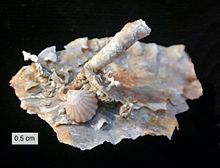

Replacement occurs when the shell, bone, or other tissue is replaced with another mineral. In some cases mineral replacement of the original shell occurs so gradually and at such fine scales that microstructural features are preserved despite the total loss of original material. A shell is said to be recrystallized when the original skeletal compounds are still present but in a different crystal form, as from aragonite to calcite.[၉]
Adpression (compression-impression)
[ပလေဝ်ဒါန် | ပလေဝ်ဒါန် တမ်ကၞက်]Compression fossils, such as those of fossil ferns, are the result of chemical reduction of the complex organic molecules composing the organism's tissues. In this case the fossil consists of original material, albeit in a geochemically altered state. This chemical change is an expression of diagenesis. Often what remains is a carbonaceous film known as a phytoleim, in which case the fossil is known as a compression. Often, however, the phytoleim is lost and all that remains is an impression of the organism in the rock—an impression fossil. In many cases, however, compressions and impressions occur together. For instance, when the rock is broken open, the phytoleim will often be attached to one part (compression), whereas the counterpart will just be an impression. For this reason, one term covers the two modes of preservation: adpression.[၁၀]
Soft tissue, cell and molecular preservation
[ပလေဝ်ဒါန် | ပလေဝ်ဒါန် တမ်ကၞက်]Because of their antiquity, an unexpected exception to the alteration of an organism's tissues by chemical reduction of the complex organic molecules during fossilization has been the discovery of soft tissue in dinosaur fossils, including blood vessels, and the isolation of proteins and evidence for DNA fragments.[၁၁][၁၂][၁၃][၁၄] In 2014, Mary Schweitzer and her colleagues reported the presence of iron particles (goethite-aFeO(OH)) associated with soft tissues recovered from dinosaur fossils. Based on various experiments that studied the interaction of iron in haemoglobin with blood vessel tissue they proposed that solution hypoxia coupled with iron chelation enhances the stability and preservation of soft tissue and provides the basis for an explanation for the unforeseen preservation of fossil soft tissues.[၁၅] However, a slightly older study based on eight taxa ranging in time from the Devonian to the Jurassic found that reasonably well-preserved fibrils that probably represent collagen were preserved in all these fossils and that the quality of preservation depended mostly on the arrangement of the collagen fibers, with tight packing favoring good preservation.[၁၆] There seemed to be no correlation between geological age and quality of preservation, within that timeframe.
Carbonization and coalification
[ပလေဝ်ဒါန် | ပလေဝ်ဒါန် တမ်ကၞက်]Fossils that are carbonized or coalified consist of the organic remains which have been reduced primarily to the chemical element carbon. Carbonized fossils consist of a thin film which forms a silhouette of the original organism, and the original organic remains were typically soft tissues. Coalified fossils consist primarily of coal, and the original organic remains were typically woody in composition.
-
Carbonized fossil of a possible leech from the Silurian Waukesha Biota of Wisconsin.
Bioimmuration
[ပလေဝ်ဒါန် | ပလေဝ်ဒါန် တမ်ကၞက်]
Bioimmuration occurs when a skeletal organism overgrows or otherwise subsumes another organism, preserving the latter, or an impression of it, within the skeleton.[၁၈] Usually it is a sessile skeletal organism, such as a bryozoan or an oyster, which grows along a substrate, covering other sessile sclerobionts. Sometimes the bioimmured organism is soft-bodied and is then preserved in negative relief as a kind of external mold. There are also cases where an organism settles on top of a living skeletal organism that grows upwards, preserving the settler in its skeleton. Bioimmuration is known in the fossil record from the Ordovician[၁၉] to the Recent.
Types
[ပလေဝ်ဒါန် | ပလေဝ်ဒါန် တမ်ကၞက်]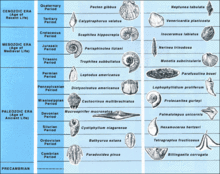
Index
[ပလေဝ်ဒါန် | ပလေဝ်ဒါန် တမ်ကၞက်]Index fossils (also known as guide fossils, indicator fossils or zone fossils) are fossils used to define and identify geologic periods (or faunal stages). They work on the premise that, although different sediments may look different depending on the conditions under which they were deposited, they may include the remains of the same species of fossil. The shorter the species' time range, the more precisely different sediments can be correlated, and so rapidly evolving species' fossils are particularly valuable. The best index fossils are common, easy to identify at species level and have a broad distribution—otherwise the likelihood of finding and recognizing one in the two sediments is poor.
Trace
[ပလေဝ်ဒါန် | ပလေဝ်ဒါန် တမ်ကၞက်]Trace fossils consist mainly of tracks and burrows, but also include coprolites (fossil feces) and marks left by feeding.[၂၀] Trace fossils are particularly significant because they represent a data source that is not limited to animals with easily fossilized hard parts, and they reflect animal behaviours. Many traces date from significantly earlier than the body fossils of animals that are thought to have been capable of making them.[၂၁] Whilst exact assignment of trace fossils to their makers is generally impossible, traces may for example provide the earliest physical evidence of the appearance of moderately complex animals (comparable to earthworms).[၂၂]
Coprolites are classified as trace fossils as opposed to body fossils, as they give evidence for the animal's behaviour (in this case, diet) rather than morphology. They were first described by William Buckland in 1829. Prior to this they were known as "fossil fir cones" and "bezoar stones." They serve a valuable purpose in paleontology because they provide direct evidence of the predation and diet of extinct organisms. Coprolites may range in size from a few millimetres to over 60 centimetres.
-
A coprolite of a carnivorous dinosaur found in southwestern Saskatchewan
-
Densely packed, subaerial or nearshore trackways (Climactichnites wilsoni) made by a putative, slug-like mollusk on a Cambrian tidal flat
Transitional
[ပလေဝ်ဒါန် | ပလေဝ်ဒါန် တမ်ကၞက်]A transitional fossil is any fossilized remains of a life form that exhibits traits common to both an ancestral group and its derived descendant group. This is especially important where the descendant group is sharply differentiated by gross anatomy and mode of living from the ancestral group. Because of the incompleteness of the fossil record, there is usually no way to know exactly how close a transitional fossil is to the point of divergence. These fossils serve as a reminder that taxonomic divisions are human constructs that have been imposed in hindsight on a continuum of variation.
Microfossils
[ပလေဝ်ဒါန် | ပလေဝ်ဒါန် တမ်ကၞက်]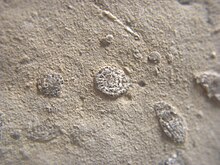
Microfossil is a descriptive term applied to fossilized plants and animals whose size is just at or below the level at which the fossil can be analyzed by the naked eye. A commonly applied cutoff point between "micro" and "macro" fossils is 1 mm. Microfossils may either be complete (or near-complete) organisms in themselves (such as the marine plankters foraminifera and coccolithophores) or component parts (such as small teeth or spores) of larger animals or plants. Microfossils are of critical importance as a reservoir of paleoclimate information, and are also commonly used by biostratigraphers to assist in the correlation of rock units.
Resin
[ပလေဝ်ဒါန် | ပလေဝ်ဒါန် တမ်ကၞက်]
Fossil resin (colloquially called amber) is a natural polymer found in many types of strata throughout the world, even the Arctic. The oldest fossil resin dates to the Triassic, though most dates to the Cenozoic. The excretion of the resin by certain plants is thought to be an evolutionary adaptation for protection from insects and to seal wounds. Fossil resin often contains other fossils called inclusions that were captured by the sticky resin. These include bacteria, fungi, other plants, and animals. Animal inclusions are usually small invertebrates, predominantly arthropods such as insects and spiders, and only extremely rarely a vertebrate such as a small lizard. Preservation of inclusions can be exquisite, including small fragments of DNA.
Derived, or reworked
[ပလေဝ်ဒါန် | ပလေဝ်ဒါန် တမ်ကၞက်]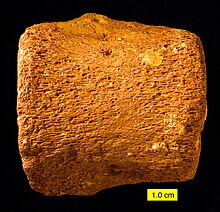
A derived, reworked or remanié fossil is a fossil found in rock that accumulated significantly later than when the fossilized animal or plant died. Reworked fossils are created by erosion exhuming (freeing) fossils from the rock formation in which they were originally deposited and their redeposition in a younger sedimentary deposit.
Wood
[ပလေဝ်ဒါန် | ပလေဝ်ဒါန် တမ်ကၞက်]Fossil wood is wood that is preserved in the fossil record. Wood is usually the part of a plant that is best preserved (and most easily found). Fossil wood may or may not be petrified. The fossil wood may be the only part of the plant that has been preserved:[၂၃] therefore such wood may get a special kind of botanical name. This will usually include "xylon" and a term indicating its presumed affinity, such as Araucarioxylon (wood of Araucaria or some related genus), Palmoxylon (wood of an indeterminate palm), or Castanoxylon (wood of an indeterminate chinkapin).[၂၄]
Subfossil
[ပလေဝ်ဒါန် | ပလေဝ်ဒါန် တမ်ကၞက်]
The term subfossil can be used to refer to remains, such as bones, nests, or defecations, whose fossilization process is not complete, either because the length of time since the animal involved was living is too short (less than 10,000 years) or because the conditions in which the remains were buried were not optimal for fossilization. Subfossils are often found in caves or other shelters where they can be preserved for thousands of years.[၂၅] The main importance of subfossil vs. fossil remains is that the former contain organic material, which can be used for radiocarbon dating or extraction and sequencing of DNA, protein, or other biomolecules. Additionally, isotope ratios can provide much information about the ecological conditions under which extinct animals lived. Subfossils are useful for studying the evolutionary history of an environment and can be important to studies in paleoclimatology.
Subfossils are often found in depositionary environments, such as lake sediments, oceanic sediments, and soils. Once deposited, physical and chemical weathering can alter the state of preservation.
Chemical fossils
[ပလေဝ်ဒါန် | ပလေဝ်ဒါန် တမ်ကၞက်]Chemical fossils, or chemofossils, are chemicals found in rocks and fossil fuels (petroleum, coal, and natural gas) that provide an organic signature for ancient life. Molecular fossils and isotope ratios represent two types of chemical fossils. The oldest traces of life on Earth are fossils of this type, including carbon isotope anomalies found in zircons that imply the existence of life as early as 4.1 billion years ago.
Dating
[ပလေဝ်ဒါန် | ပလေဝ်ဒါန် တမ်ကၞက်]Paleontology seeks to map out how life evolved across geologic time. A substantial hurdle is the difficulty of working out fossil ages. Beds that preserve fossils typically lack the radioactive elements needed for radiometric dating. This technique is our only means of giving rocks greater than about 50 million years old an absolute age, and can be accurate to within 0.5% or better.[၂၆] Although radiometric dating requires careful laboratory work, its basic principle is simple: the rates at which various radioactive elements decay are known, and so the ratio of the radioactive element to its decay products shows how long ago the radioactive element was incorporated into the rock. Radioactive elements are common only in rocks with a volcanic origin, and so the only fossil-bearing rocks that can be dated radiometrically are volcanic ash layers, which may provide termini for the intervening sediments.
Stratigraphy
[ပလေဝ်ဒါန် | ပလေဝ်ဒါန် တမ်ကၞက်]Consequently, palaeontologists rely on stratigraphy to date fossils. Stratigraphy is the science of deciphering the "layer-cake" that is the sedimentary record. Rocks normally form relatively horizontal layers, with each layer younger than the one underneath it. If a fossil is found between two layers whose ages are known, the fossil's age is claimed to lie between the two known ages. Because rock sequences are not continuous, but may be broken up by faults or periods of erosion, it is very difficult to match up rock beds that are not directly adjacent. However, fossils of species that survived for a relatively short time can be used to match isolated rocks: this technique is called biostratigraphy. For instance, the conodont Eoplacognathus pseudoplanus has a short range in the Middle Ordovician period. If rocks of unknown age have traces of E. pseudoplanus, they have a mid-Ordovician age. Such index fossils must be distinctive, be globally distributed and occupy a short time range to be useful. Misleading results are produced if the index fossils are incorrectly dated. Stratigraphy and biostratigraphy can in general provide only relative dating (A was before B), which is often sufficient for studying evolution. However, this is difficult for some time periods, because of the problems involved in matching rocks of the same age across continents. Family-tree relationships also help to narrow down the date when lineages first appeared. For instance, if fossils of B or C date to X million years ago and the calculated "family tree" says A was an ancestor of B and C, then A must have evolved earlier.
It is also possible to estimate how long ago two living clades diverged, in other words approximately how long ago their last common ancestor must have lived, by assuming that DNA mutations accumulate at a constant rate. These "molecular clocks", however, are fallible, and provide only approximate timing: for example, they are not sufficiently precise and reliable for estimating when the groups that feature in the Cambrian explosion first evolved,[၂၇] and estimates produced by different techniques may vary by a factor of two.[၂၈]
Limitations
[ပလေဝ်ဒါန် | ပလေဝ်ဒါန် တမ်ကၞက်]
Organisms are only rarely preserved as fossils in the best of circumstances, and only a fraction of such fossils have been discovered. This is illustrated by the fact that the number of species known through the fossil record is less than 5% of the number of known living species, suggesting that the number of species known through fossils must be far less than 1% of all the species that have ever lived.[၂၉] Because of the specialized and rare circumstances required for a biological structure to fossilize, only a small percentage of life-forms can be expected to be represented in discoveries, and each discovery represents only a snapshot of the process of evolution. The transition itself can only be illustrated and corroborated by transitional fossils, which will never demonstrate an exact half-way point.[၃၀]
The fossil record is strongly biased toward organisms with hard-parts, leaving most groups of soft-bodied organisms with little to no role. It is replete with the mollusks, the vertebrates, the echinoderms, the brachiopods and some groups of arthropods.
Sites
[ပလေဝ်ဒါန် | ပလေဝ်ဒါန် တမ်ကၞက်]Lagerstätten
[ပလေဝ်ဒါန် | ပလေဝ်ဒါန် တမ်ကၞက်]Fossil sites with exceptional preservation—sometimes including preserved soft tissues—are known as Lagerstätten—German for "storage places". These formations may have resulted from carcass burial in an anoxic environment with minimal bacteria, thus slowing decomposition. Lagerstätten span geological time from the Cambrian period to the present. Worldwide, some of the best examples of near-perfect fossilization are the Cambrian Maotianshan shales and Burgess Shale, the Devonian Hunsrück Slates, the Jurassic Solnhofen limestone, and the Carboniferous Mazon Creek localities.
Stromatolites
[ပလေဝ်ဒါန် | ပလေဝ်ဒါန် တမ်ကၞက်]
Stromatolites are layered accretionary structures formed in shallow water by the trapping, binding and cementation of sedimentary grains by biofilms of microorganisms, especially cyanobacteria.[၃၁] Stromatolites provide some of the most ancient fossil records of life on Earth, dating back more than 3.5 billion years ago.[၃၂]
Pseudofossils
[ပလေဝ်ဒါန် | ပလေဝ်ဒါန် တမ်ကၞက်]နိဿဲ
[ပလေဝ်ဒါန် | ပလေဝ်ဒါန် တမ်ကၞက်]- ↑ theNAT :: San Diego Natural History Museum :: Your Nature Connection in Balboa Park :: Frequently Asked Questions. Sdnhm.org.
- ↑ "Oldest fossil found: Meet your microbial mom"။
- ↑ "Microbially Induced Sedimentary Structures Recording an Ancient Ecosystem in the ca. 3.48 Billion-Year-Old Dresser Formation, Pilbara, Western Australia" .
- ↑ "Oldest 'microfossils' raise hopes for life on Mars"။
"Geological Team Lays Claim to Oldest Known Fossils"။ - ↑ "Hints of life on what was thought to be desolate early Earth"၊ Mindspark Interactive Network။
- ↑ "Potentially biogenic carbon preserved in a 4.1 billion-year-old zircon" . Early edition, published online before print.
- ↑ "Early Archean fossil bacteria and biofilms in hydrothermally influenced sediments from the Barberton greenstone belt, South Africa" (2001). Precambrian Research 106 (1–2): 93–116. doi:. Bibcode: 2001PreR..106...93W.
- ↑ (2013) Bringing fossils to life : an introduction to paleobiology, Third, New York: Columbia University Press, 8. ISBN 9780231158930။
- ↑ ၉.၀ ၉.၁ ၉.၂ ၉.၃ ၉.၄ Prothero 2013.
- ↑ "Palaeobotany in museums" (1986). Geological Curator 4: 553–559.
- ↑ Fields H (May 2006). "Dinosaur Shocker - Probing a 68-million-year-old T. rex, Mary Schweitzer stumbled upon astonishing signs of life that may radically change our view of the ancient beasts". Smithsonian Magazine.
- ↑ "Soft-tissue vessels and cellular preservation in Tyrannosaurus rex" (2005-03-25). Science.
- ↑ "Molecular analyses of dinosaur osteocytes support the presence of endogenous molecules" (January 2013). Bone.
- ↑ "Identification of Proteinaceous Material in the Bone of the Dinosaur Iguanodon" (2003). Connective Tissue Research.
- ↑ "A role for iron and oxygen chemistry in preserving soft tissues, cells and molecules from deep time" (Nov 2013). Proceedings of the Royal Society.
- ↑ Zylberberg. "Analysis of fossil bone organic matrix by transmission electron microscopy". Comptes Rendus Palevol.
- ↑ "Parasitism of Ordovician bryozoans and the origin of pseudoborings" .
- ↑ Taylor. "Preservation of soft-bodied and other organisms by bioimmuration: A review". Palaeontology.
- ↑ Wilson. "Earliest preservation of soft-bodied fossils by epibiont bioimmuration: Upper Ordovician of Kentucky". Lethaia.
- ↑ What is paleontology?. University of California Museum of Paleontology.
- ↑ e.g. "How valid is Cruziana Stratigraphy?" .
- ↑ The Rise of Animals: Evolution and Diversification of the Kingdom Animalia. JHU Press။
- ↑ Ed Strauss (2001). Petrified Wood from Western Washington. Archived from the original on 2010-12-11။ Retrieved on 2021-03-11။
- ↑ Wilson Nichols Stewart (1993). Paleobotany and the evolution of plants။
- ↑ Subfossils Collections.
- ↑ Martin, M.W. (5 May 2000). "Age of Neoproterozoic Bilaterian Body and Trace Fossils, White Sea, Russia: Implications for Metazoan Evolution". Science.
- ↑ "The Impact of Fossils and Taxon Sampling on Ancient Molecular Dating Analyses" (2007). Molecular Biology and Evolution 24: 889–1897.
- ↑ "Origin of the Eumetazoa: Testing ecological predictions of molecular clocks against the Proterozoic fossil record" (2005). Proceedings of the National Academy of Sciences 102: 9547–52.
- ↑ Prothero. Evolution: What the Fossils Say and Why It Matters။
- ↑ Isaak. Claim CC200: There are no transitional fossils..
- ↑ "The term stromatolite: towards an essential definition" (2007). Lethaia 32: 321–330.
- ↑ You must specify title = and url = when using {{cite web}}..



